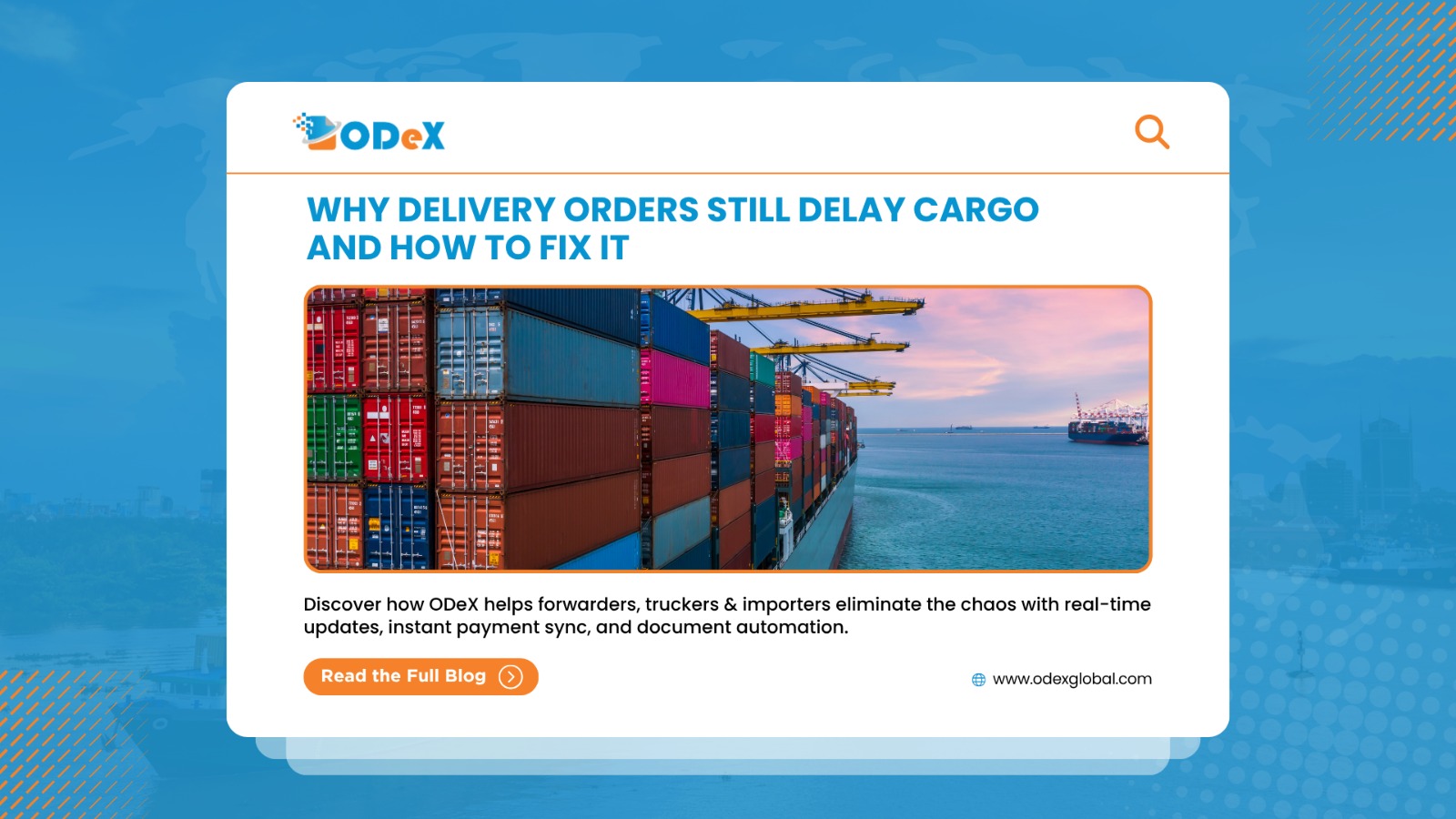The Delivery Order dilemma: Why timely release matters more than ever
For anyone involved in moving containers—from freight forwarders and truckers to port operators and importers—the delivery order (DO) is a critical document. It is the last mile’s green light, granting the trucker permission to pick up the container once it has been cleared.
As global shipping volumes grow more complex and time-sensitive, the humble delivery order sometimes becomes a silent source of cost, delay, and frustration across the supply chain.
When delivery orders are delayed, containers sit. Trucks idle. Charges mount. And with supply chain volatility now a given, there is less room for error than ever.
Why does timely delivery orders matter, what causes the common delays, and how ODeX’s digital documentation and payment platforms help stakeholders ensure cargo is released smoothly and on time.
Why delivery orders are the linchpin of container movement
A delivery order is the final authorisation for a consignee or their agent (often a trucker or third-party logistics provider) to collect a cargo container from the port or terminal. It signifies that the ocean freight has been paid, documentation is complete, and customs formalities are cleared.
While this document might seem procedural, it sits at the intersection of several workflows:
- Freight payment processing
- Bill of Lading validation
- Terminal coordination
- Customs clearance
- Trucker dispatch scheduling
Any delay in one of these steps delays the issuance of the DO—and therefore, the release of the cargo.
What happens when DOs are late?
When a delivery order is not issued in time, the consequences are immediate and measurable:
1. Demurrage Charges
Containers left at the port beyond the free period incur daily penalties, which can range from $100 to $400 or more per day depending on the port and carrier. These charges often snowball because documentation was not completed or payment was not confirmed in time.
2. Truck Scheduling Chaos
Truckers are often scheduled days in advance. If a DO is not released when expected, drivers may arrive at the terminal only to be turned away. This leads to idle time, wasted fuel, and loss of earnings.
3. Storage Fees at Off-Dock Locations
In some regions, if containers are not moved promptly, they are shifted to off-dock storage where additional handling and storage fees apply.
4. Customer Service Breakdowns
Delayed delivery orders affect importers’ ability to get products to market on time. For time-sensitive shipments—retail goods, perishables, or automotive parts—the repercussions can extend deep into customer service and revenue forecasts.
Why are DOs still delayed in a digital age?
Despite widespread digital transformation in the shipping industry, several factors continue to plague the timely release of delivery orders:
- Manual workflows: Many freight forwarders still rely on manual email threads or printed documents to request and receive DOs.
- Payment verification lags: Bank wires or delayed payment reconciliations slow down the process.
- Fragmented systems: Lack of integration between stakeholders (forwarders, terminals, carriers) means information must be chased manually.
- Late document submissions: Errors in Bills of Lading, incorrect consignee details, or missing supporting documents can delay validation.
These bottlenecks are not technological limitations, they are process limitations. And they can be solved.
A closer look at the trucking perspective
Independent truckers and hauliers, particularly in the U.S., are among the most impacted by DO delays. Most operate on tight schedules and razor-thin margins. A missed port pickup is not just a lost trip—it often means a lost day.
When truckers do not receive confirmation that the container is ready for pickup, they face a dilemma
-
Gamble on showing up at the terminal, risking rejection or
-
Wait for updates and risk missing available slots or incurring penalties
The result? Revenue uncertainty, operational inefficiency, and avoidable stress in an already demanding job.
How ODeX helps ensure timely Delivery Orders
While ODeX is not the only player offering digital freight tools, its specific focus on streamlining documentation and payment flows gives users a practical edge.
Here is how ODeX helps forwarders, truckers, and importers stay on top of delivery orders:
1. Integrated Payment + Document Workflow
Once a payment is made via ODeX (using PayPal, bank transfer, or other integrated options), the system immediately notifies the carrier or terminal. This speeds up the internal release process.
2. Real-Time Status Tracking
Users can track the status of DO requests—whether pending, under review, or released—in real time. This gives forwarders and truckers the clarity to plan accordingly.
3. Auto-Notifications and Alerts
ODeX sends automatic updates when a DO is approved or when a required step (like payment confirmation or B/L validation) is pending. This eliminates the need to chase stakeholders by email or phone.
4. Audit Trail for Every Transaction
All actions taken—payment, submission, approvals—are recorded with timestamps, making compliance easier and disputes less frequent.
Subtle but powerful: The impact of timely DOs
Ensuring that a container can be picked up on the right day, at the right time, sounds simple. But it is one of the most critical points of coordination in international shipping. And as margins tighten and customer expectations rise, that point of coordination becomes a key source of competitive advantage.
Timely DOs mean:
-
Lower demurrage
-
Better trucker efficiency
-
Faster delivery to end customers
-
Reduced admin overhead for logistics teams
It is not about flashy tech—it is about execution.
Conclusion: Efficiency in the Last Mile Starts with the First Document
A delayed DO today can trigger a chain of costs and complications tomorrow. That is why it is essential for freight forwarders, truckers, and cargo owners to not just track their cargo—but also to track the documents that unlock it.
Digital platforms like ODeX help eliminate the silent inefficiencies that used to be accepted as part of the process.
By making payment, documentation, and release confirmation faster and more transparent, they help ensure that the delivery order is no longer a bottleneck—but a bridge to faster cargo movement.
In global trade, the small details still matter. And getting the delivery order right is one of the most important ones.


















